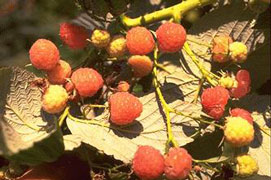


Home
Flowers &
Indoor Plants
Fruits & Nuts
Ornamentals
Vegetables
Special Topics
Resources
Glossary

|
Raspberry Rubus idaeus (roo-bus i-day-us)  Click on thumbnails for larger image. |
 |
What about it? Raspberries are very similar to the i r close cousin, the blackberry. However, raspberries will come off the plant "cored" while the blackberries hold on tight to the core, or receptacle, in their middle. There are red, yellow, black, and purple raspberries. There are fall- and summer-bearing types. What is it used for? Raspberries can be processed into purees, preserves, jellies, juices, and yogurt. Raspberries are especially enjoyed fresh. Where does it grow? How do we grow it? Raspberries require relatively cool summer and moderate winter temperatures for best production. Raspberry roots are very sensitive to "wet feet" and generally surrender to a fungus problem called Phytophthora root rot in poorly drained soil. Otherwise, they are relatively tolerant of a wide range of conditions. Raspberry rows are spaced 8 to 10 feet apart, depending on the vigor of the cultivar. Spacing between the plants ranges between 30 to 36 inches. Raspberries fruit on the two-year-old canes; these should be pruned out ofter they have finished fruiting. What are its primary problems? Principal diseases of the raspberry include mosaic viruses, leaf curl virus, crown gall, rust, and caneblight. The most common insects include aphids, cane and crown borers, and mites. How do we harvest and store it? Fruit must be picked and handled very carefully. It should be firm and well colored. Harvest every 1 to 3 days to maintain high quality. Raspberries have a short shelf life, so they should be used right away.
© Copyright, Department of Horticulture, Cornell University. |